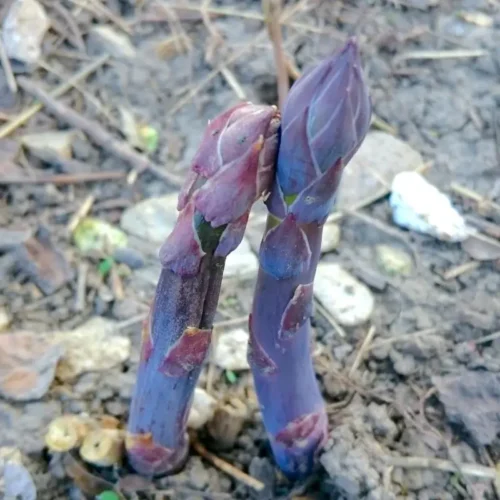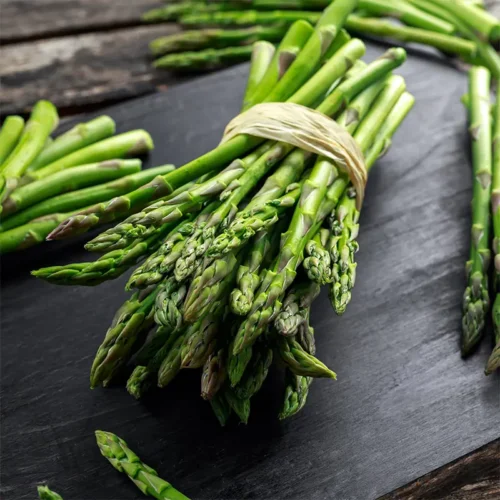Growing asparagus can seem intimidating, but fresh asparagus spears are actually fairly simple to plant and harvest. When you buy asparagus crowns, you may not realize that you are getting a perennial crop with multiple harvests in a season.
You may decide to add a single type of asparagus plant, or decide to go the way I did and plant multiple varieties including Mary Washington, Sweet Purple asparagus, and Jersey Knight asparagus. Either way, growing asparagus is attainable even for beginner gardeners, and learning how to harvest asparagus is quite straightforward. Let’s master when and how to pick asparagus!

How Long After Planting Asparagus Can You Harvest?
Asparagus spears are not the crop for those that like instant gratification from their garden. (Try radishes or baby spinach for that!) You can harvest asparagus the first year after planting, but you will likely kill your plants, since they won’t be able to retain enough food reserves to sustain themselves.
It’s best to wait and start harvesting asparagus in the plants’ third year of life. You can shorten how many years it takes to harvest asparagus by purchasing older plants when you are ready to start your asparagus bed. For instance, if you purchase one year old plants, you can harvest asparagus the second year of growth, saving a year.
When to Harvest Asparagus
Regardless of variety, asparagus spears are best when they’re 6–12 inches in length and about the width of a pencil. This allows for the most tenderness and versatility, since fatter and taller spears have the potential to be stringy and tough. Harvest season usually takes place in the late spring into summer. This is likely May and June in the northern hemisphere. Southern hemisphere gardeners will harvest September-October. There is some variability among garden zones, with warmer areas seeing results sooner.
I’m in Zone 4b and see my first asparagus just before my birthday in late May (best birthday present ever!) However, asparagus is most successfully and frequently grown in northern climates, as the heat in the southern US is challenging to a robust crop.
Once your asparagus bed is productive, you should be able to harvest every two days or so. If you live in a colder climate like me, you may find that there are going to be some freezing nights even after the harvest season has started. In this case, it is a good idea to harvest all spears, regardless of size. Some may be smaller than you typically prefer, but leaving them exposed to frost can damage the texture of the spear and its continuing growth. Smaller spears are still perfectly fine to eat!
My family likes spears 6-8 inches, but as long as they aren’t tough, we are equal opportunity consumers! Let us know in the comments what size spears are your preferred choice!
While asparagus is typically a spring crop, there have been some studies that experiment with fall harvests. This can be achieved by planting twice as many plants and not picking from half of the plants in the spring, but letting them turn to ferns. In midsummer cut all of the ferns back. This should result in a second wave of growth, allowing you to harvest asparagus in the fall. I’ve not tried this myself, but it is something that definitely interests me—a taste of spring in autumn!

When is the Best Time to Harvest Asparagus?
When is the best time of day to harvest asparagus? Unlike some plants, there isn’t a specific time of day in which it is better to grab your spears from the garden. However, if you are harvesting asparagus in wetter conditions, on a rainy day or in the early morning, it may be a good idea to dry the tops of the spears so they don’t harbor excessive moisture and preserve their freshness longer.
How Do You Harvest Asparagus?
When it comes to how to harvest asparagus, the task itself is pretty simple! There are two ways to harvest asparagus: cutting and snapping. Neither is necessarily the best way to harvest asparagus, as individual preference is the biggest differentiating factor here. Neither method, if done correctly, affects the mother plant differently than the other.
If you choose to snap your asparagus, you will simply choose the location on the stem you wish to snap and gently bend the stem with your thumb and one or two fingers. If the stem is healthy, it should break cleanly. You may experience some resistance if the stem is especially thick or older, as it will start to get tough and woody.

Or, you may use a sharp knife (curved knives are often recommended) to cut the stem. In either method, knowing where to pick asparagus is important to consider. The stem should be cut or snapped close to the soil line.
No matter how you pick asparagus, make sure that you are careful not to damage surrounding plants or the crown itself while doing so. This is more likely to happen if you are using a knife or cutting in an area you can’t see. Damaged stems will be unlikely to grow to maturity properly, and damage to the mother plant can prevent future successful harvests.
I personally prefer using the snap method. It’s simple, I don’t have to carry a tool with me, and there is no risk to surrounding plants.
Do you prefer the snapping or cutting method? Let us know in the comments!
When to Stop Harvesting Asparagus
While you can harvest asparagus in waves, it is important not to continue picking too late in the season. Persistent harvesting can cause undue stress to plants and may reduce future production. The time to stop picking asparagus doesn’t always have a clear deadline. But, your asparagus harvest season should last approximately 6-8 weeks.
Even if you haven’t reached this time frame, it’s probably time to stop harvesting if you see:
- slowed growth
- smaller spear width
- small ferns forming
In my zone, in 4b, late June-early July marks the end of asparagus picking season. In your first harvest season, you may wish to harvest for a shorter duration in order to reduce pressure on the plants.
As far as how many times you can harvest asparagus during this window, when you see an ideal stem, it’s fair game, unless you’d like to let some plants go to seed for seed saving. A well-maintained asparagus plant can allow for 20 years of production. In our Resprout Garden Planting & Harvesting spreadsheet, you can track your harvest on a weekly and annual basis, so you’ll be able to compare your asparagus production from year to year.
Storing Asparagus

When it comes to deciding how to store fresh-picked asparagus, I’ve found that simple is best! I place my spears in a cup or jar of cold water and place in the fridge. Storing asparagus in the fridge helps them retain their crispness and flavor. Asparagus can be stored for a couple of weeks, but their taste quality and sweetness decline with time. This is no concern in my house as we eat them grilled, air fried, or roasted as fast as we pick them (maybe a sign I need to expand my patch).
Asparagus can be eaten fresh, pickled, canned, and frozen to extend the harvest for year-round enjoyment. Blanching asparagus before freezing them allows for maximum flavor and nutrition retention. After blanching, you can spread them in a single layer on a cookie sheet, freeze, and then transfer to a freezer bag for long term storage.
Please share some of your favorite recipes and ways to enjoy asparagus in the comments!
Sources:
- Asparagus, UC Davis Vegetable Research & Information Center
- Growing Vegetables: Asparagus, University of New Hampshire Extension.
- Harvesting Asparagus, University of Minnesota Extension, 2023.





Leave a Reply